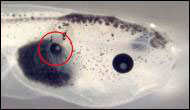The manipulation of the electrical status of cells allowed scientists at Tufts University, Massachusetts to grow fully formed eyes in the intestines and on the tail of tadpoles. As strange as it sounds, the demonstrated result is an important step towards the regeneration of complex organs and the evolution of design.
In earlier work, the researchers managed to grow a new tail for the tadpole to replace the lost one. To do this, they changed the electrical properties of cells by stimulating their absorption of salt. These and later results indicate that not only chemical, but also physical factors play an important role in the development of the animal organism in the direction of cell differentiation.
The membranes of all cells have a certain electrical potential, which is formed due to the difference in the concentrations of charged ions of sodium, potassium and calcium in the intra- and extracellular space. The movement of ions across the membrane is regulated by so-called ion channels. For most cells, in addition to nerve and muscle, the charges created by these currents are very small and are expressed in millivolts. However, it turned out that the difference in potentials of different cells plays an important role in the migration and development of cells.
The researchers found that about 19 hours after fertilization of the Xenopus laevis Xenopus laevis egg, the membrane potential of some cells in the embryo was reduced by about 20 millivolts. At the site of localization of these cells, the eyes of the animal are subsequently formed. At the same time, the introduction of compounds that block the change in potential prevents the formation of eyes.
To test the hypothesis that the electrical properties of the cell play an important role in the formation of the eye, the scientists have embedded ion channels, allowing to create a characteristic decrease in membrane potential, into the cells of the intestine and tail of tadpoles. As a result, each stimulation of these channels led to the formation of an additional eye in the selected localization.
Previously, experts believed that eyes can only form from head cells that express certain regulatory proteins. However, it turned out that the primary signal in this case is a change in potential, which somehow triggers the production of the necessary proteins.
The researchers believe that in the future, similar approaches could be used to stimulate the formation of organs from stem cells in the laboratory. However, some experts doubt the success of such experiments, since the course of the process of organ formation is most likely determined by a change in the electrical status of the cell relative to the surrounding cells, and not simply by reaching a certain level of membrane potential.
